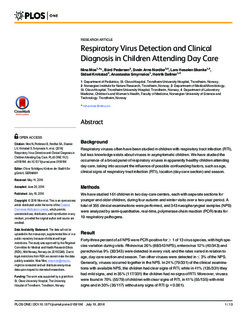| dc.description.abstract | Background:
Respiratory viruses often have been studied in children with respiratory tract infection (RTI), but less knowledge exists about viruses in asymptomatic children. We have studied the occurrence of a broad panel of respiratory viruses in apparently healthy children attending day care, taking into account the influence of possible confounding factors, such as age, clinical signs of respiratory tract infection (RTI), location (day-care section) and season.
Methods:
We have studied 161 children in two day-care centers, each with separate sections for younger and older children, during four autumn and winter visits over a two-year period. A total of 355 clinical examinations were performed, and 343 nasopharyngeal samples (NPS) were analyzed by semi-quantitative, real-time, polymerase chain reaction (PCR) tests for 19 respiratory pathogens.
Result:
Forty-three percent of all NPS were PCR-positive for ≥ 1 of 13 virus species, with high species variation during visits. Rhinovirus 26% (88/343 NPS), enterovirus 12% (40/343) and parechovirus 9% (30/343) were detected in every visit, and the rates varied in relation to age, day-care section and season. Ten other viruses were detected in ≤ 3% of the NPS. Generally, viruses occurred together in the NPS. In 24% (79/331) of the clinical examinations with available NPS, the children had clear signs of RTI, while in 41% (135/331) they had mild signs, and in 35% (117/331) the children had no signs of RTI. Moreover, viruses were found in 70% (55/79) of children with clear signs of RTI, in 41% (55/135) with mild signs and in 30% (35/117) without any signs of RTI (p < 0.001).
Conclusions:
Positive PCR tests for respiratory viruses, particularly picornaviruses, were frequently detected in apparently healthy children attending day care. Virus detection rates were related to age, presence of clinical signs of RTI, location in day care and season. | nb_NO |

